Could someone help me to find the pole expression in the circuit shared below? The expression of the zero is: (Wz=-1/(R8*C2)), but I'm unable to find the pole location due to R8 (without it I would be able to find the pole).
-
Do you mean R9 or R8? – Andy aka Jun 02 '23 at 11:07
-
For this topology I mean R8, but I’m puzzled cause of these two resistor. As the pole location doesn’t depend on where we are taking input or output but only on the topology of the circuit , if I consider the ideal voltage source equal to 0V (so shorted) , we go back to the previous schematic that I had put, and R9 have also an impact… I’m just trying to find the pole related to this circuit – AnalogMan Jun 02 '23 at 11:30
2 Answers
To determine the poles - there are two of them - set the excitation voltage to 0 V (replace the input source by a wire) and "look" through the connections of each capacitor to determine the resistance \$R\$ that drives it. It is a fairly simple exercise which can be carried by inspection, without writing a line of algebra:
Once you have the time constants in hand, a solver like Mathcad will plot the final transfer function, unveiling magnitude and phase responses:
I used the fast analytical circuits techniques or FACTs to determine this transfer function. You can have a look at my APEC 2016 seminar to discover the method.
- 20,420
- 1
- 16
- 50
Well, notice that the transfer function of your circuit is given by:
\begin{equation} \begin{split} \mathscr{H}\left(\text{s}\right)&=\frac{\text{V}_\text{o}\left(\text{s}\right)}{\text{V}_\text{i}\left(\text{s}\right)}\\ \\ &=\frac{\displaystyle\left(\text{R}_8+\frac{1}{\text{sC}_2}\right)\space\text{||}\space\frac{1}{\text{sC}_7}}{\displaystyle\left(\left(\text{R}_8+\frac{1}{\text{sC}_2}\right)\space\text{||}\space\frac{1}{\text{sC}_7}\right)+\text{R}_9}\\ \\ &=\frac{\displaystyle\frac{\displaystyle\left(\text{R}_8+\frac{1}{\text{sC}_2}\right)\frac{1}{\text{sC}_7}}{\displaystyle\text{R}_8+\frac{1}{\text{sC}_2}+\frac{1}{\text{sC}_7}}}{\displaystyle\frac{\displaystyle\left(\text{R}_8+\frac{1}{\text{sC}_2}\right)\frac{1}{\text{sC}_7}}{\displaystyle\text{R}_8+\frac{1}{\text{sC}_2}+\frac{1}{\text{sC}_7}}+\text{R}_9}\\ \\ &=\frac{\displaystyle1+\text{C}_2\text{R}_8\text{s}}{\displaystyle\text{C}_2\text{C}_7\text{R}_8\text{R}_9\text{s}^2+\left(\text{C}_2\left(\text{R}_8+\text{R}_9\right)+\text{C}_7\text{R}_9\right)\text{s}+1} \end{split}\tag1 \end{equation}
Where \$\alpha\space\text{||}\space\beta:=\frac{\displaystyle\alpha\beta}{\displaystyle\alpha+\beta}\$.
Now, we can see that:
$$1+\text{C}_2\text{R}_8\text{s}=0\space\Longleftrightarrow\space\text{s}=-\frac{1}{\text{C}_2\text{R}_8}\tag2$$
- 7,203
- 12
- 21
-
Yes for the Zero, even without equation It's possible to find it ... my question was related to the pole, I was trying to find the pole without doing the equation (just by inspection) – AnalogMan Jun 02 '23 at 15:29
-
No - in general, it is NOT possible to find the poles "just by inspection". This also applies to zeros. This is because for many networks poles and zeros are not real but complex. In your example, there is only one single REAL zero. Therefore, it could be determined by inspection of the circuit. – LvW Jun 02 '23 at 15:47
-
There is lot of case where it’s possible to find pole and zero by inspection ( by inspection I mean you will do quick math , only few line) instead of writing all the transfert function. For exemple for pôle , if it’s only passive element you can try to find the conditions for witch your impedance goes to infinity and you will get your pole … For Zero it’s quite easier juste determine the condition to have your output equal to 0V ( for example Vout tied to gnd or two path toward Vout with one path frequency dependent or no path between VIN and Vout – AnalogMan Jun 02 '23 at 16:18
-
@AnalogMan, if I may, the zero is determined with a *nulled* response, not when the output is tied to ground. It simply means that when the source is tuned to the zero frequency, the stimulus is lost in the circuit and does not produce a response, hence the 0-V ac signal. – Verbal Kint Jun 02 '23 at 20:13
-
@VerbalKint , I agree with you, but vout tied to gnd means vout = 0V (H(s) = 0), which is what I meant... For example, for the circuit above, at a certain frequency (-1/R8*C2), Vout is tied to gnd , so as you say the stimulus at that frequency is lost and we have no response. – AnalogMan Jun 02 '23 at 20:51
-
I see what you mean. We are talking about a *transformed short circuit*, similar to what a virtual ground would do. It is described in my seminar. – Verbal Kint Jun 03 '23 at 07:58
-


